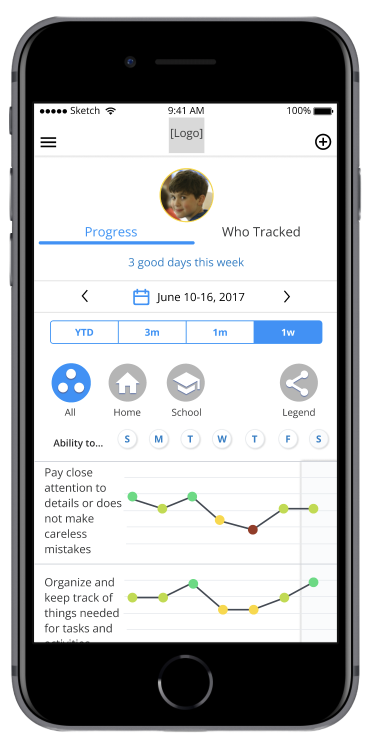Supporting Patients with ADHD: Parent Mobile App
Problem
How might we help parents of children with ADHD have more “good days”?
Approach
Integrate new feature into a post-alpha native mobile app for parents of children diagnosed with ADHD. Update features in a responsive web app for teachers.
Impact
Our efforts led to additional long-term projects and our design was executed in final released app — 5 years later.
Design Approach
The client approached us needing additional user research and design support to prepare the app for market launch and FDA approvals.
We were asked to integrate new support methods tracking and management into the in-progress mobile app for parents and responsive web app for teachers.
At the time, the app enabled parents to track frequency of positive behaviors. and the integration of support methods would help parents identify the impact of those methods on behavior, resulting in “more good days”
Agile and rapid collaboration
The client and I communicated via Slack, where I shared sketches almost daily for quick iteration and client trust.
My fellow designer and I conducted two working sessions per week where we could sketch on product requirements, provide feedback, answer questions, and align on our ideas.
Why is tracking supports a good idea?
Parents of children diagnosed with ADHD
They are central to patient success. They help their child take medications, change their behaviors to give the child support, coach the child in self-regulation and track the child’s progress to share with providers.
They manage day-to-day, one day at a time. Each day is a chance to have a “good day” and daily tracking gives them a chance to know what happens each day.
They need help zooming out. Since parents manage ADHD in the moment, they need help looking back and seeing what has/hasn’t been working.
Client
Healthcare Startup
Duration
8 weeks (Oct.-Dec. 2017)
My Role
Lead Product Designer
Collaborators
1 User Researcher, 1 Product Designer, 1 Product Manager (client)
Teachers of children diagnosed with ADHD
They spend significant amounts of time with patients. Of the 6,000 waking hours of a student, 1,000 hours are spent in school.
They see children in unique environments and use different supports. Knowing what works in school could inform a child’s home life.
Client Kickoff & Aligning on Approaches
Our client contact (center in floral) managed both product management and design internally. We’d work incredibly close throughout the entire project.
In our kickoff, we aligned on project goals, reviewed existing research, discussed design principles and did some brainstorming.
We developed many ideas in the workshop that conflicted with each other, so I used conceptual diagrams to clarify key approaches and ensure consistency across the app.
Parent User Testing Validated Key Concepts
It (Mostly) Worked
⛔️ Onboarding
Searching was not intuitive because parents didn’t know what to search for.
They would prefer select options from a list.
After a couple weeks of rapid design and feedback with the client, we prepared for usability testing with medium fidelity wireframes for 4 key workflows:
Onboarding: Adding support methods
Daily tracking: Associating support methods to the day
Analyzing data: Reviewing good days and what support methods were used
Check-ins: Monthly diary with reflection and review support methods
✅ Analyzing Data
Parents liked overview ratings and seeing that in relation to the day they used a support method.
They liked uncovering patterns that might indicate what’s not working in a month view.
✅ Check-ins
Parents liked the reminder to review supports and behaviors they were tracking.
This was especially valuable after meeting with medical providers.
✅ Daily Tracking
Parents take a lot of responsibility for how their child does in a day.
Tracking methods was incredibly valuable as a way to be consistent with their child.
Final Parent App & Impact
When we finalized the designs, there was not yet an existing public brand. So, we utilized Material Design as a base for showing how the color palettes and hierarchy would look.
I included final visual design and interaction spec, in addition to user flows.
As a result of this work, this client requested a longer-term, larger engagement to support development and develop more features.
In the 5 years since this work was completed, the final app (ADHD Insight) uses much of the same interactions and design for tracking and analysis.
BONUS: Teacher Experience!
When we ran usability tests on the parent mobile app, we also tested medium-fidelity wireframes of 3 key workflows for teacher tracking.
Onboarding: Accepting the parent invite to the product
Daily tracking: Logging school supports for each student
Analyzing data: Reviewing which supports lead to better outcomes
We wanted to learn how teachers would react to tracking school accommodations and strategies, and how to present data for analysis.
Teacher Testing Revealed Incorrect Assumptions
Teachers had great privacy concerns and how the data they tracked would be used by parents.
The tracking granularity used for parents was not relevant to teachers, and so the app needed to consider the teacher context and tracking requirements for learning plans (the legally required documentation for children with disabilities).
Final Teacher Invite
Usability testing debunked our client’s assumptions on the teacher use case. So, we saved time and resources by descoping this feature for the teacher app, but we did implement a new invite screen for further study during the alpha release.
Changes to the invite screen included more explanation of the data privacy and access, in addition to screenshots of what parents see in their app.
Teachers like the data and how involved the parent was in tracking. They generally saw this as an easier way to communicate with parents about what happens at school.










